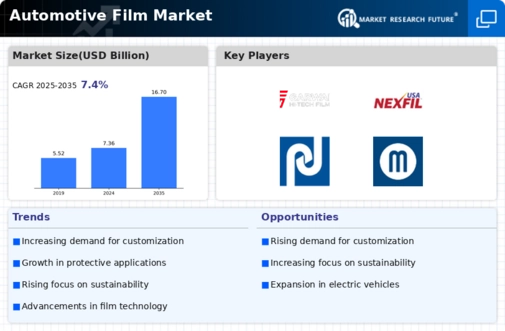Top Industry Leaders in the Automotive Film Market
 The Automotive Film market, is not just about keeping out the sun's glare. It's a bustling arena where aesthetics, safety, and technology collide, creating a vibrant landscape where established brands and innovative startups battle for every square inch of windshields and windows. But beneath the shimmering surface lies a complex competitive jungle, where navigating shifting trends and evolving regulations is key to survival.
The Automotive Film market, is not just about keeping out the sun's glare. It's a bustling arena where aesthetics, safety, and technology collide, creating a vibrant landscape where established brands and innovative startups battle for every square inch of windshields and windows. But beneath the shimmering surface lies a complex competitive jungle, where navigating shifting trends and evolving regulations is key to survival.
Strategies Tinting the Market Landscape:
-
Product Diversification: Leading players like 3M, Johnson Window Films, and Llumar are constantly pushing the boundaries, developing films with enhanced heat rejection, shatter resistance, UV protection, and even night-vision-compatible tints. Think ceramic films for maximum heat mitigation, security films for added protection, and customizable films for unique aesthetic expressions. -
Vertical Integration: Securing reliable sources of key raw materials like polyester and adhesives is crucial. Some companies, like Madico, are investing in backward integration to gain control over the supply chain and optimize costs. -
Focus on Sustainability: Environmental consciousness is shaping the market. Players are adopting greener production processes, using recycled materials, and developing eco-friendly adhesives to minimize environmental impact and cater to sustainability-driven customers. -
Geographical Expansion: Emerging economies in Asia and Africa present immense growth potential, driven by rising disposable incomes and increasing car ownership. Companies like NXP and SunTek are establishing production facilities and forging partnerships in these regions to capitalize on this trend.
Factors Influencing Market Share:
-
Safety and Security: Stringent regulations on UV protection and window tinting laws drive the demand for films with safety features and compliance certificates. Companies meeting these standards gain a competitive edge. -
Aesthetics and Customization: Growing demand for personalized car experiences fuels the adoption of tinted films with diverse colors, shades, and finishes. Think chameleon films that change color with light and films incorporating custom designs or logos. -
Technological Advancements: Research and development efforts are leading to self-healing films, films with integrated sensors, and even smart films that adjust tint levels automatically based on ambient conditions. Early adopters and innovators stand to benefit significantly from these advancements. -
Consumer Preferences: Rising awareness of health benefits like UV protection and skin cancer prevention, coupled with increased interest in car aesthetics, fuels the demand for high-quality automotive films.
Key Companies in the Automotive Film market include
- Avery Dennison Corporation. (U.S.)
- HEXIS S.A. (France)
- 3M (U.S.)
- Eastman Chemical Company (U.S.)
- Arlon Graphics, LLC. (U.S.)
- MATERIAL SCIENCES CORPORATION (U.S.)
- DuPont (U.S.)
- Garware Suncontrol (India)
- NEXFIL (U.S.)
- Johnson Window Films, Inc. (U.S.)
- Saint-Gobain Performance Plastics (France)
- Madico, Inc. (U.S.)
- Kay Premium Marking Films LTD (UK)
Recent Developments
-
September 2023: A fire at a major polyester production facility in China disrupts global supply chains, leading to temporary shortages and price hikes for automotive films. -
October 2023: 3M unveils a new line of self-healing automotive films, addressing concerns about scratches and abrasions, and opening doors for new applications. -
November 2023: A consortium of leading research institutions and film manufacturers launches a collaborative project to develop smart films with integrated heat sensors and automatic tinting adjustments, enhancing comfort and energy efficiency. -
December 2023: The Automotive Film market exhibits signs of continued growth, driven by increasing demand from safety-conscious and car-loving consumers, technological advancements, and growing interest in eco-friendly solutions.

